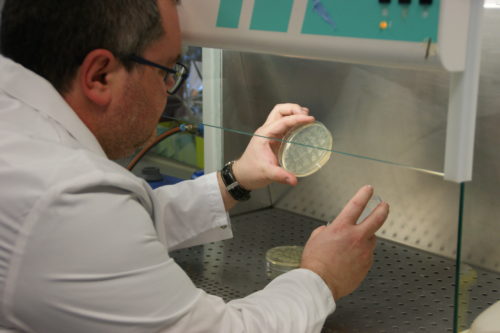Nevertheless, some of these infections are known to be composed of multiple combinations of bacteria, involving complex interactions that can influence their fitness, their antibiotic tolerance and can therefore worsen the disease outcome.
Scientists have been addressing this issue for years, but the coexistence between species that occurs in some infections remains hard to achieve in vitro, since bacterial fitness differences eventually lead to a single organism dominating the mixed culture.
In more recent years, the discovery of the culture conditions able to maintain mixed P. aeruginosa and S. aureus –two major pathogens commonly found growing together in intricate biofilms in disease-affected lungs or wounds– simultaneous growth in vitro has become a scientific hotspot, and several studies can be found in the bibliography addressing the interactions of these microorganisms.
Now researchers at Institute for Bioengineering of Catalonia (IBEC) and at the University of Barcelona (UB) studying the coexistence of P. aeruginosa and S. aureus have realized that antibiotic resistance of both species is critically increased during coculture biofilm growth.
Moreover, the experts have discovered that S. aureus survival is strictly dependent on oxygen diffusion, which allows the formation of a mature mixed biofilm with stable populations of P. aeruginosa and S. aureus.
The findings have been published in the journal Scientific Reports in an article in which the researchers decipher the optimal coculture conditions and environmental requisites that would allow the simultaneous and stable growth of P. aeruginosa and S. aureus in mixed biofilms over time.
In this regard, the authors specify that the antimicrobial susceptibilities of P. aeruginosa and S. aureus differ depending on whether they are growing in monoculture or coculture in biofilms.
“Our research will help to evaluate and choose the best antimicrobial therapy to treat bacterial chronic infections”, explains in this connection Eduard Torrents, one of the authors of the study.
In short, the study of Torrents and his colleagues provides useful insights about the establishment of a P. aeruginosa and S. aureus combined biofilm in vitro, something that would be of help for the study of phenotypes derived from this clinically challenging bacterial cooperation as well as for optimizing the antimicrobial therapy used to treat these infections.
“We believe that in the near future will be better tools to choose a correct treatment for different chronic infections and for instance it will help cystic fibrosis and chronic obstructive pulmonary disease (COPD) patients to identify which is the best antibiotic treatment need it for each patient”, concludes Torrents.
Reference ARticle: Cendra, M.d.M., Blanco-Cabra, N., Pedraz, L. and Torrents, E. (2019) Optimal environmental and culture conditions allow the in vitro coexistence of Pseudomonas aeruginosa and Staphylococcus aureus in stable biofilms. Sci Rep 9, 16284, https://doi.org/10.1038/s41598-019-52726-0






